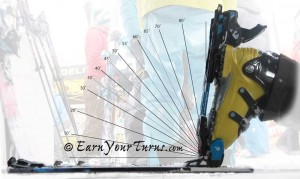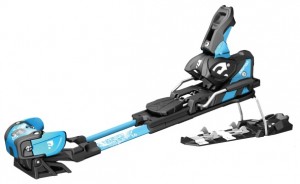One of the priorities of the recent outdoor trade show season was to spend some time on-snow with the new alpine touring binding from Salomon and Atomic. Regardless of the brand name, it’s the same binding with a different name and colors – Salomon’s Guardian or Atomic’s Tracker.
With my feet encased inside a pair of Scarpa Hurricane’s and a pair of Ascension climbing skins I headed out from the Salomon demo tent at Outdoor Retailer’s On-Snow Demo Day at Solitude resort. The Guardian was mounted to a pair of fat, rockered Salomon skis that would be one of my last choices for a backcountry ski, but they were adequate for evaluating the binding.As for downhill performance, I’ll confess there wasn’t much to evaluate. Being used to a permanently free heel there is little to distinguish in turn mode other than I had zero trouble holding an edge even on the very firm and scrappy conditions available at Solitude. It was, afterall, predominantly man-made snow and the four-footer that hit the Wasatch in late January was yet to arrive.
As for huckability, I’ll trust the conclusions of Salomon’s athletes that it can take the heat and not blow up. Airtime is something I indulge in only by accident.
What I was most interested in was the touring capability of the Guardian. In the field there was no apparent limit to the range of motion. Back at the demo tent I confirmed it swung resistance free for more than 90°.
The key difference between the Guardian and it’s main competitor is the ability to switch it into touring mode without exiting the binding. Some will argue that this is a minor improvement and I concur, but the judges at ISPO deemed it worthy of an award based on this feature alone.With telemark gear the ability to switch on the fly between locked and free modes does have value on short traverses and long flat stretches. For alpine, a free heel on a traverse without skins has little value and if you’re switching to uphill mode you need to eject from your bindings anyway to put the climbing skins on. Nonetheless having the option seems worthwhile for the occasional long flat stretch where stopping long enough to add skins doesn’t make sense.
The real question is, how easy is it to use?
Not as easy as expected. It does require a bit of technique and I have little doubt that with regular use the correct ‘touch’ with a ski pole would become second nature. However my first few attempts required having to figure out the correct combination of pressure and angle. It usually took about three tries to get it right. Once the plate was freed at the heel, it was easy to flip up the climbing bar for a straight up attack on the slope, or flip it another click forward for a relatively flat ascent angle if you prefer to zig-zag up the hill.
Switchback kick turns were super easy with the tail of the ski naturally falling away so all I needed to do was pivot the ski around. That may have been due to the binding being mounted fairly forward due to the rockered nature of the ski, thus creating more weight at the rear. Since there is no spring to restrict pivoting I’m sure there would be no issues if the binding were mounted in a more centered location.
Was there anything not to like about the Guardian/Tracker? Only the weight, which tips the scales around 6½ pounds, but if you’re looking seriously at the Guardian or Tracker that extra heft is the price of assurance you’ll gladly suffer for having reliable landing gear after earning your air.For those demanding lots of power, the Guardian has an 80mm footprint for transferring lots of power to your skis edges, even super fatties, yet it suspends your foot a mere 26mm above the top sheet to provide lots of sensitivity and responsiveness to changing snow conditions.
Since I’ve only logged one climb on this rig and it was not the sort of conditions that causing icing I can’t comment on the propensity for that to happen. I’m sure it does in some situations, and the reality is that tendency won’t really be known until reports from a multitude of early adopters filters back.
While there are plans for a lower release value than DIN 16 (which, by the way isn’t a true DIN since the DIN scale maxes out at 12), next year’s bindings will all have steroidally enhanced release springs with a relative value adjustable between 7–16. The only real choices will be whether you want a small or standard sized frame, and a blue hued Guardian or a mellow yellow Tracker.
In either case, it heralds the recognition by the greater community of alpine ski manufacturers of the growing interest in earning turns outside resort boundaries. Marker was first to see the opportunity with the Duke, and Salomon/Atomic brands confirm the strength of that market segment by joining the fray.
Salomon
Guardian
MSRP: $550
Weight: 6½ lbs. (2.95 kg) per pair
Related Posts:
Salomon’s new AT binding
Update on Salomon Guardian
© 2012



1 comment
4 pings
“$85 a pound”…
Funny, but noteworthy.
[…] really no serious competition for its reputation. With the advent of competition from Tyrolia and Salomon it is clear skiers have voted resoundingly with their wallets, yes, we want to ski anywhere and […]
[…] As expected, Salomon will be offering a lighter weight, lower DIN Guardian next year, simply titled the Guardian 13. For many folks the 16 DIN is overkill, especially when it […]
[…] the still heavier Duke binding with release values up to DIN 16, followed by Salomon’s DIN 16 Guardian and Tyrolia’s DIN 16 Adrenaline. Sales of the Freeride have declined ever […]
[…] Related Posts First Look at Salomon’s Guardian […]